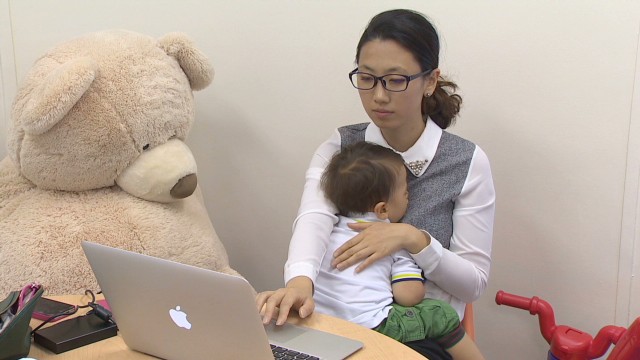Can`womenomics' save Japan?

So said Japan's Prime
Minister Shinzo Abe in April as he outlined a raft of measures aimed at
closing the gender gap in the Japanese workforce.
As a Western journalist
new to Japan, it is a shock that it takes an economic argument to move
the government to act toward more female participation in the workforce.
But it's not just a foreign perspective. The noted economist Noriko
Hama writes in the Japan Times this week, "You secure better working
conditions for women because they have a rightful claim to such
treatment. No other reasoning or justification is necessary to do
something that is decent and just."
Nevertheless, if you are a
prime minister in urgent search of growth, the numbers behind so-called
"womenomics" in Japan are compelling.
'If you were to close the
employment gap between Japanese men, which is 80%, one of the highest
in the OECD, with Japanese women -- which is still around 60% -- we
estimate that you'd add about 8.2 million workers into the Japanese
workforce," says Kathy Matsui of Goldman Sachs, who has long championed
the cause. That influx of female workers "could lift the asset level of
Japanese GDP by as much as 14%," she adds.
Now Prime Minister Abe is
trying to force corporations to act. He has set targets of at least one
female executive per company and offered tax incentives to companies
that encourage mothers to return to work.
Despite equal employment
opportunities enshrined into law in 1986, real equality within most
domestic Japanese companies remains within the realm of fantasy-land.
Naoko Toyoda had worked
for 10 years with an IT company but was demoted to a starting position
when she came back after the birth of her first child. "Women who choose
not to have a child would continue up the corporate ladder while those
who did would be forced into semi-retirement," she says.
She didn't expect
flexibility from the company's side though. "Once one exception is
allowed, other mothers would complain they weren't treated in the same
way," she says. So she quit.
According to Goldman
Sachs, some 70% of Japanese women choose to leave the workforce after
they've had children. That's more than twice the number in the U.S. or
Germany.
But unlike the U.S. and
Germany -- where childcare is cited as the major factor for why women
leave work -- in Japan, uncompromising work environments, which demand
face-time and offer little career mobility for women, persuade most
mothers to give up corporate life.
A 2011 study by the Center for Work-Life Policy called "Off-Ramps and On-Ramps Japan: Keeping Talented Women on the Road to Success" found
that three quarters of Japanese women want to rejoin the workforce
after they've had children, but only 43% manage to get their careers
back on track. Those who do return to work tend to take salary cuts and
often find themselves, like Toyoda, marginalized within the company.
Cosmetics giant Shiseido
does better than most. Since 1990 its childcare support program has
been in continual evolution, providing employees with extensive leaves
of parental absence, shorter working hours, childcare subsidies and
on-site nursery facilities. It is also working on a gender equality
action plan to boost its ratio of female leaders though it admits it
will miss its slated target of 30% by end 2013.
Women who choose not to have a child would continue up the
corporate ladder while those who did would be forced into
semi-retirement.
Naoko Toyoda
Naoko Toyoda
Shigeto Ohtsuki,
executive director of human resources at Shiseido, describes the
management style in the past as "very slow moving." Even though Shiseido
is an example of corporate best practice in Japan, Ohtsuki admits there
is still some way to go along the road towards true daibashitii, the
Japanese word for diversity.
"The female leader ratio
in Japan Shiseido Group, representing 25,000 employees is still 25.6%
whereas female leader ratio overseas where we have 20,000 employees is
almost 60%," Ohtsuki says.
Yuki Honda joined
Shiseido in 1989. She met her husband there and they have two children.
She feels grateful to the company for continuing to support and promote
her throughout. "I think I was fortunate with this company because they
did not assume we women would quit after childbirth and they educated us
so we'd continue to work," she says.
Japan's bleak
demographic outlook is well known. The birth-rate is shrinking, the
population is getting older and there are fewer workers' to pay for the
nation's pensioners. The IMF forecasts Japan's population will shrink by
around 30% by 2055.
Abe's push to make the
workplace a more hospitable place for women -- quite apart from the
argument that it's just more fair -- is also a matter of economic
survival.
Whether Japan's male corporate bosses are listening remains to be seen.
No comments:
Post a Comment